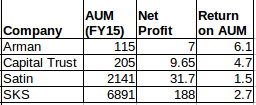SATIN CREDITCARE NETWORK LTD :
http://www.satincreditcare.com/index.php
Satin Creditcare Network Limited (SCNL) was formed in 1990 as a Non-Banking Finance Company (NBFC) with the simple concept of providing individual loans to urban shopkeepers for tiny businesses by Mr. Harvinder Pal Singh. Since then the company has expanded and evolved into one of the leading microfinance institutions in India with its current geography in North as well as Central India.
SCNL provides loans to both urban poor and rural poor to meet their productive requirements in starting new business or for growing an existing business. The company’s microfinance operation is based on both Joint Liability Group(JLG) model as well Self Help Group model (SHG).
At present, SCNL has its strong presence and serves its clients throughout Bihar, Chandigarh, Delhi, Haryana, Jammu , Maharashtra, Madhya Pradesh, Punjab, Rajasthan, Uttar Pradesh and Uttrakhand . In addition to the above SCNL is also listed on Delhi, Jaipur, Ludhiana, Culcutta and National stock exchange recently.
It is backed by very strong financial institutions. Partners - http://www.satincreditcare.com/our-partner.php
Particulars 2011 2012 2013 2014 2015
Total Revenue (Cr.) 58.62 56.23 94 191 324
PAT (Cr.) 2.17 1.4 4 15.5 31.7
Total Assets (Cr.) 294 316 745 1115 2010
Book value was around 66/- as on March 2015.
SCNL received CARE Ratings of MFI 1 (MFI One) grading - the top most category in MFIs grading.
As on March 31, 2014, the Gross NPA percentage was 0.02% while Net NPA percentage was Nil.
Previous CARE report - http://www.careratings.com/upload/CompanyFiles/RR/Satin%20Creditcare%20Network%20Limited-07-21-2014.pdf
June 2015 results - http://www.satincreditcare.com/pdf/Financial-Results-June-15.pdf
Latest shareholding pattern - http://www.satincreditcare.com/pdf/Shareholding-pattern-Jun-2015.pdf
Latest Annual report - http://www.satincreditcare.com/pdf/Book-final-05.pdf
Many YouTube videos are also available - https://www.youtube.com/results?search_query=satin+creditcare
Positives:
India is a huge market for microfinance – it has more than 400 million poor seeking an opportunity to reduce their vulnerabilities, create assets and ensure income security. India’s microfinance sector is lauded as a savior of the poor and a good bet for investors.
According to industry reports, microfinance institutions (MFIs) would grow at an annual pace of 30%-35% over the next three years on the back of improved fund availability. MFIs have committed to opening at least 30 million bank accounts within a year through tie-ups with banks as part of the government’s ambitious financial inclusion plan recently announced.
More can be read at…
https://www.linkedin.com/pulse/microfinance-institutions-mfis-growing-breed-india-arup-das
Satin’s presence in underpenetrated north and central India micro finance market provides ample opportunity for sustainable future growth.
Good asset quality.
Points covered as above.
Negatives:
Satin (And even big brother SKS) was not given small bank license by RBI. If given, it would have helped satin to bring down borrowing cost, reduce political uncertainty and more lending flexibility. Anyways it is backed by strong muscles that liquidity won’t be any problem for Satin. Borrowing in last few months shows credentials.
More can be read at
I am not aware about competitive advantage satin enjoys in North and Central India, but overall market is huge and many companies can coexist and grow.
This is my first attempt of starting a new thread. Views are invited.
Disclosure: Bought few share at 190/- and its 5% of my portfolio.

